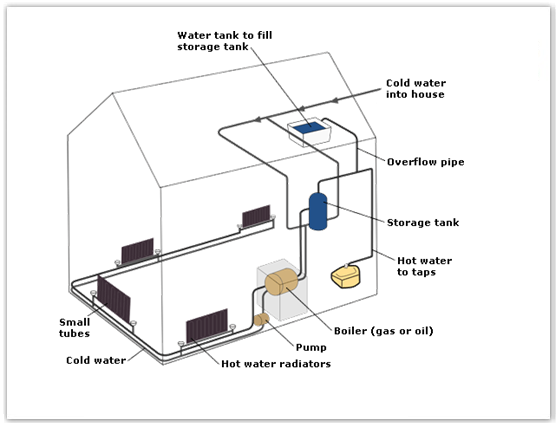You should spend about 20 minutes on this task.
The diagram below shows how a central heating system in a house works. Summarise the information by selecting and reporting the main features, and make comparisons where relevant.
Write at least 150 words.

Sample Answer 1
The diagram shows how a central heating system of a house works. The illustration shows that the central heating machine comprises several mechanical aspects and forms a complex system.
According to the given illustration, for the central heating machine to work, the cold water supply is required, and this water flows to the storage tank, and the overflow pipe is there to store the excess water in storage. The water is passed through a boiler which is either gas or oil driven, and a pump is connected to it. The radiators are connected to the boiler and are made of tiny tubes. When the cold water passes through the pump and boiler, it gains temperature and becomes hot water, and from the water taps, the house members get hot water. Thus the whole system that covers the house keeps it warm.
In summary, the central heating system mainly works by flowing water through the house and increasing its temperature of it.
Sample Answer 2
The given picture illustrates how a central heating system operates in a typical house to keep the internal climate and tap water at a pre-set temperature. The process runs through two stages, starting at a transitory state until reaching a steady state.
In the transitory stage, the main goal is to fill the heater´s piping circuit with water. Initially, cold water is taken from the local water utility supplier and passed through a boiler, which is a device designed to exchange energy between burned fuel (gas or oil) and water; this fluid is then pumped through some tubes and radiators, which are equipment used for exchanging temperature between the running fluid and the air inside the house. Finally, water reaches back to the boiler. The amount of water taken from the utility service has a specific volume according to an engineering design; this stage repeats until the water gets a predefined temperature.
Once the system has reached the pre-set temperature, it gets to a steady state. Thanks to the high pressure on the piping circuit, water is transported to a storage tank from the boiler. After the storage tank is completed, water runs down to a sink. When the pressure is again high enough, water deviates towards a spare water tank, which functions as a water reserve for interrupted service.
Sample Answer 3
This diagram explains how the domestic central heating system works in a home. The trend suggests how the tank, boiler and pipes ensure a constant hot water flow to the radiators and the taps.
The cold water enters the house through a pipe and then is kept in a cold-water storage tank. If too much water is in this tank, the overflow pipe directs the excess water to the water storage tank in the roof. From there, the water flows down to the house’s ground floor boiler.
Fueled by gas or oil, the boiler heats the water as it passes through. The hot water is pumped around the house through a system of pipes and flows into the radiators in different rooms. The water circulates through the radiators, with small tubes inside them to help distribute the heat, warming each room. Some water is directed to the taps to provide hot water for the house.
Once the water has gone through the pipes and radiators, it is returned to the boiler to be re-heated and re-circulated throughout the house.
